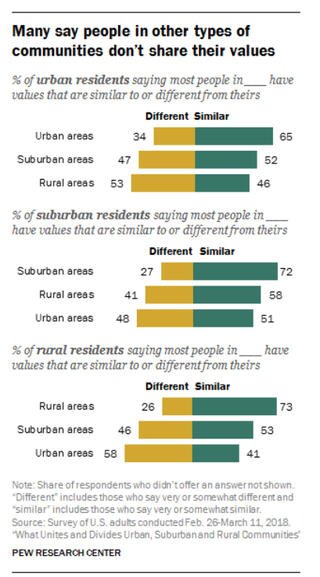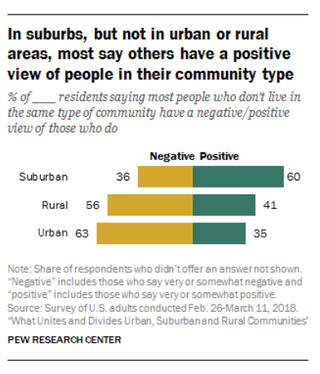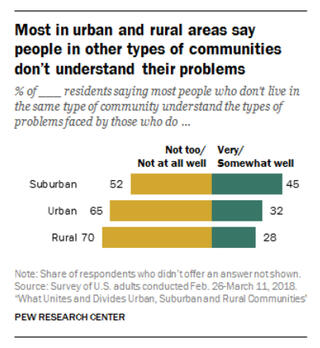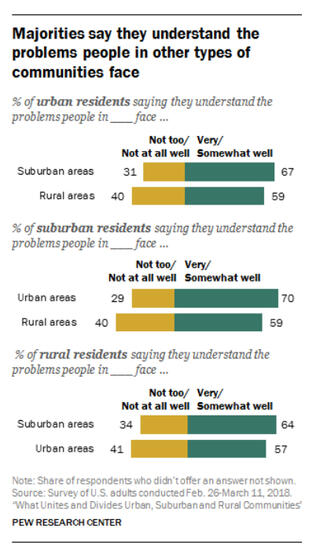How Urban, Suburban, and Rural Communities View One Another: Pew Research Study
Subject
- English & Language Arts
Language
English — USUpdated

From the Pew Research Center study, "What Unites and Divides Urban, Suburban and Rural Communities"
Data Report 1: A majority of rural Americans see a values gap between themselves and urban dwellers 1
About seven-in-ten adults in rural (73%) and suburban (72%) areas, and 65% in urban areas, say most people who live in the same type of community as they do have values that are very or somewhat similar to their own. When it comes to whether they have values in common with people who live in other types of communities, however, the public is more divided.
Among urban dwellers, 46% say most people in rural areas have values that are similar to theirs, while 53% say the values of rural Americans are very or somewhat different. This is in line with the way urban adults view those in the suburbs: 52% say people in the suburbs generally share their values, 47% say they don’t.
Like those in urban areas, rural residents are also divided on whether the values of suburbanites are generally similar to (53%) or different from (46%) theirs. But a majority of rural dwellers (58%) say urban Americans have values that are very or somewhat different from their own.
Suburbanites are somewhat more likely to say they have values in common with people in rural areas than with those who live in cities: 58% in the suburbs say most people in rural areas have values that are very or somewhat similar to theirs, compared with 51% who say the same about people in urban areas.
- 1All text and graphs from Kim Parker, Juliana Menasce Horowitz, Anna Brown, Richard Fry, D’vera Cohn, and Ruth Igielnik, “What Unites and Divides Urban, Suburban, and Rural Communities," Pew Research Center, May 22, 2018.

From the Pew Research Center study, "What Unites and Divides Urban, Suburban and Rural Communities"
Data Report 2: Majorities in urban and rural areas say others have a negative view of people in their type of community
In urban and rural areas alike, more than half (63% and 56%, respectively) say people who don’t live in their type of community have a very or somewhat negative view of those who do. In contrast, 60% of those in suburban areas say most people who live outside of the suburbs have a very or somewhat positive view of suburban residents.
For the most part, opinions on this don’t vary across demographic groups, but urban and rural residents with a bachelor’s degree or more education are more likely than their less educated counterparts to say those outside of urban and rural areas have a negative view of those who live in these types of communities. About seven-in-ten college graduates in urban (72%) and rural (69%) areas say others have a negative view of people in their community type; 59% of those with some college or less education in urban areas and 53% in rural areas say the same.

From the Pew Research Center study, "What Unites and Divides Urban, Suburban and Rural Communities"
Data Report 3: Most in urban and rural areas say people in other types of communities don’t understand their problems
Solid majorities in rural (70%) and urban (65%) areas say people who live outside of these areas don’t understand the types of problems faced in these types of communities; smaller shares in suburban areas (52%) say most people in other types of communities don’t understand the problems suburbanites face. Suburban residents who say they live very far from the city are more likely than those who live very close or somewhat close to the city to say most people who don’t live in the suburbs don’t understand the types of problems they face (66% vs. 49% and 50%, respectively).
While there are no racial differences in the views of urban and suburban dwellers, whites in rural areas are far more likely than their nonwhite counterparts to say people outside of rural areas don’t understand the types of problems people in their type of community face: 74% of rural whites say this is the case vs. 57% of nonwhites in rural parts of the country.
Among rural and urban dwellers, those with more education are particularly likely to feel that others lack understanding of the types of problems people in their type of community face. For example, 82% of rural residents with a bachelor’s degree or more education – vs. 74% of those with some college experience and 63% with a high school diploma or less – say people outside of rural areas don’t understand the types of problems rural Americans face. In cities, 73% of college graduates and 67% of those with some college experience say people outside of urban areas don’t understand the types of problems people in their community face; 56% of those with a high school diploma or less education say this is the case.

From the Pew Research Center study, "What Unites and Divides Urban, Suburban and Rural Communities"
Data Report 4: Majorities say they understand the problems people in other types communities face
While many Americans, particularly in urban and rural areas, don’t think others understand the problems people in their type of community face, majorities say they personally understand the problems faced by people in other types of communities very or somewhat well. This is the case among urban, suburban and rural residents asked about each of the other two types of communities.
Among those in urban areas, 67% say they understand the types of problems people in the suburbs face; 59% say the same about the problems experienced by rural residents. Similarly, majorities of suburbanites say they understand the types of problems people in urban (70%) and rural (59%) areas face, and majorities of rural dwellers say they understand the types of problems people in suburban (64%) and urban (57%) communities experience.
Perhaps not surprisingly, people in urban, rural and suburban areas who grew up in a different type of community are particularly likely to say they understand the problems faced by those who live in the type of community where they grew up. For example, 81% of urban dwellers who grew up in a rural area say they understand the problems people in rural areas face, compared with 55% of current urban residents who grew up in an urban area and 48% of those who grew up in a suburb.
In urban and suburban communities, Republicans and Republican-leaning independents are more likely than Democrats and those who lean Democratic to say they understand the problems faced by people in rural areas. At least two-thirds of Republicans in cities (72%) and suburbs (67%) – vs. 54% and 53% of Democrats, respectively – say this. There is also a partisan gap in rural communities, with a higher share of Democrats (64%) than Republicans (54%) saying they understand the types of problems people in urban areas face.
Help students analyze this data with the Urban vs. Rural vs. Suburban Image Analysis handout and explore the lesson plan featuring these materials
How to Cite This Reading
Facing History & Ourselves, “How Urban, Suburban, and Rural Communities View One Another: Pew Research Study ”, last updated July 26, 2024.












